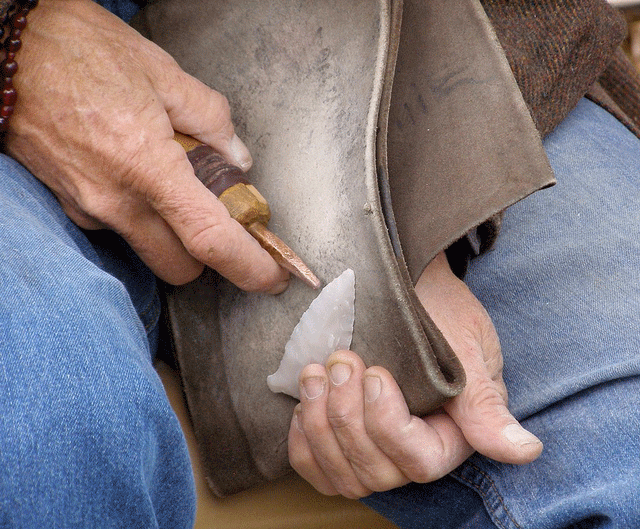
Photo by mystuart; used under Creative Commons license CC BY-NC-ND 2.0.)

Photo by mystuart;
used under Creative Commons license CC BY-NC-ND 2.0.)
Flintknapping is the shaping of rock into tools, using carefully directed blows or pressure to remove "flakes" of stone. Successful flintknapping takes two kinds of skill: you must know which types of stone to use, and you must know how to create the final shape you want.
As the name "flintknapping" suggests, flint is a stone that can be shaped in this way. Flint is a variety of chert, a silica-rich stone that is fairly common. An even better material for flintknapping is obsidian, a natural glass that forms from lava. All suitable "flaking stone" forms Hertzian cones as it breaks, and flintknapping can be defined as the art of creating Hertzian cones just where you need them. In contrast, most stone breaks along crystal faces, planes, or other structures within the rock, so instead of a tool you wind up with useless angular bits.
Suppose, however, that you have found a suitable rock to work on (and many gem and mineral stores now stock them). How do you proceed? Carefully, very carefully! After all, you're creating things that prehistoric people used to kill, skin, and butcher animals, and it's quite easy to hurt yourself. Most flintnkappers (at least the ones with both eyes and all their fingers) begin with lessons from a master. That way, they learn about the tools, techniques, and safety practices of flintknapping. Then it's just a matter of practice (lots of it) to be able to make a spear point, arrowhead, or knife blade in just a few minutes.
Here are two links to a flintknapping demonstration by
the Maxwell Museum's resident master, Dr. Bruce Huckell.
YouTube video of flintknapping (5 minute version)
YouTube video of flintknapping (15 minute version)
Most wilderness survival skills work because the user has practiced them before they became critical for survival. This is especially true of flintknapping—but with just a little training, you can at least produce a small cutting edge from a rounded pebble. The first stone tools used by humans were nothing more, and they helped the species survive for thousands of generations.
To return to the Agriculture page, please click here.
All content copyright © Maxwell Museum of Anthropology, University of New Mexico. High-resolution versons of photographs may be ordered from the Maxwell Museum's photo archives. Please make note of the catalogue numbers. For more information please visit the photo archives web page
Page last revised on February 6, 2012. Please report problems to toh@unm.edu